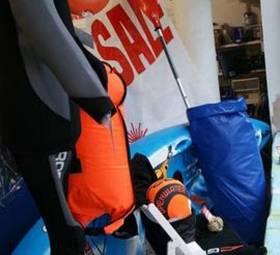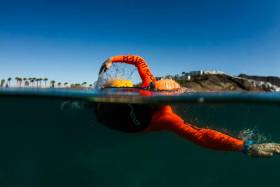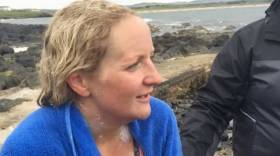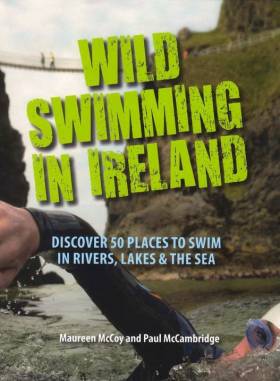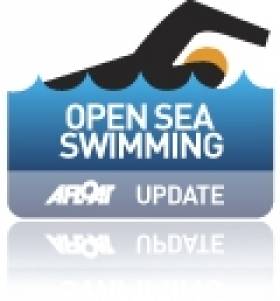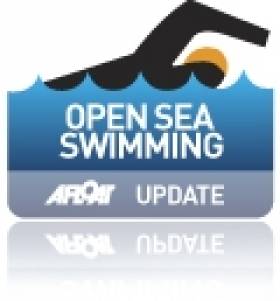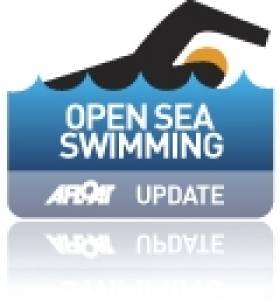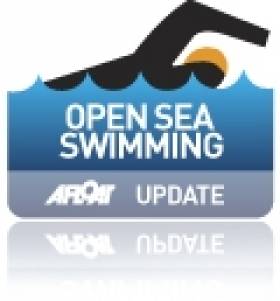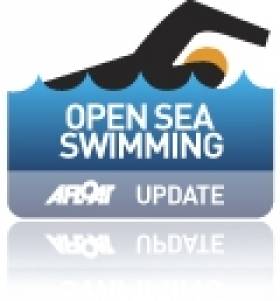Displaying items by tag: open sea swimming
Ocean Swimmer Nuala Moore on Swimming the Bering Straits
“Like a real live James Bond movie.. another absolutely insane adventure” is how the ocean and cold water swimmer Nuala Moore describes it.
She’s talking about the relay which she and Donegal swimmer Anne Marie Ward participated in to swim the Bering Straits between Russia and the US over six days, supervised by the Russian military, in 2013.
The two Irish women were among a team of 27 swimmers from 12 countries to complete the 9 km transit in four-metre waves, 80 knot northerly winds and waters of two to three degrees Celsius with “fog dropping and boats getting lost and swimmers disconnected”.
 Nuala (left) with certificate and Catherine Buckland and Chris Booker on Cape Horn
Nuala (left) with certificate and Catherine Buckland and Chris Booker on Cape Horn
The Bering Strait is regarding as one of the most unforgiving of seas and is the setting for the Discovery Channel’s “Deadliest Catch” series.
“We didn’t do a headcount but I think everyone came back...I knew Annmarie was beside me and that’s good enough,” Moore tells Wavelengths in part two of her podcast. The first part of the podcast is here
She also talks about her world record swim off Cape Horn, her work on water safety with primary schools, and with the Ocean Triple R (Remote Recovery Rescue) Emergency Care project, involving medics, nurses, swimmers and event organisers.
She also has advice on those “incredibly beautiful but quite treacherous” jellyfish.
Listen to Wavelengths below
Sailors Turned Swimmers Are all Kitted Out for Drop in Temperatures at Viking Marine
Some of us here in Viking Marine are braving the Forty Foot bathing place on Dublin Bay every morning and have to admit to nearing addiction on the daily plunge writes Ian O'Meara. Porridge is even back on the breakfast menu despite the most awful boarding school memories of lumpy gruel.
The best learning of all is that hats, gloves and socks as worn by the seasoned and learned folk in the Forty Foot vastly improves length of time in the water. So the days of being termed a 'teabagger' - the dip in dip out are over. God bless neoprene!
Our range of sea swimming gear is all on sale just in time for the drop in temperatures due this weekend and over the coming weeks. Perfect timing! More on our collection here
Viking Marine Dive Into Open Sea Swimming Gear
With amazing sea swimming spots like the Forty Foot and Seapoint nearby on Dublin Bay, Dun Laoghaire–based Viking Marine (based at the Pavillion in Dun Laoghaire opposite the Royal St. George Yacht Club) is expanding its product range for open water swimmers.
The leading Irish chandler has announced the arrival of the Orca swimming range, a leading brand in OWS and Triathlon equipment providing high-quality aerodynamic products.
Viking marine's Marion Goodall says Open water swimmers have highlighted the importance of staying visible and warm. 'This is why we brought the Orca Neoprene Swim Cap into our range. The hi-vis orange neoprene cap is cut with a built-in chinstrap making sure it is secure on your head and covers your ears preventing potential swimmer's ear while keeping you warm and visible.
To keep you visible in the water, Viking has selected Orca's Safety Buoy. Designed in a hi-vis orange material this dry bag will ensure you are seen from ashore and by boats and lifeguards.
Its built-in bladder provides swimmers with a resting cushion and a storage compartment for your valuables. When you are done swimming and you dried yourself with your Gul changing poncho, pack your wetsuit along with any other wet items in its dry bag compartment and simply throw the bag onto your shoulders thanks to its adjustable lanyard.
An ideal partner to any winter water-based activity. The cap is a perfect addition to our swimming range which includes items like the Gul Power Gloves and Rooster Supertherm Socks.
This is the start of a growing range and Viking hope to receive shortly the Orca Open Water One Piece wetsuit and other Orca products.
#SeaSwim - Charity worker Heather Clatworthy has become only the second swimmer to cross the Atlantic between the Inishowen Peninsula and Portstewart on the North Coast – and the first in nearly 90 years, according to the Irish Examiner.
The 34-year-old, who lives in Warwick with her family but grew up in Portstewart, crossed the expanse of open sea on Wednesday 27 July in around half the time expected, reaching the shore a little over four hours after setting out from Stroove beach in Moville.
“Two hours in I just didn’t think I was going to do it,” she said after powering through illness and choppy waters to complete her amazing feat, last achieved by famous English Channel swimmer Mercedes Gleitze in 1929.
The Belfast Telegraph has video of Clatworthy as she set out on her remarkable challenge:
In other sea swimming news, Galway long distance swimmer Alice Flood celebrated her swim across the English Channel earlier this week.
As the Galway Independent reports, the Bushy Park native made the gruelling crossing in just under 14 hours and joins an elite group of swimmers who've completed the England-to-France challenge.
New Book Celebrates Wild Swimming In Ireland
#WildSwimming - Wild Swimming in Ireland is a new book of photography showcasing some of the most breathtaking locations to take a dip around the island, as the Banbridge Leader reports.
Compiled by open sea swimmer Maureen McCoy and photographer Paul McCambridge – a noted open-water swimmer himself – the book, which features 50 spots for wild swimming, is hoped to be just the beginning of a series highlighting the charms and even therapeutic qualities of swimming beyond the usual beaches and pools.
From seaside spots like beneath the Carrick-a-Rede rope bridge in Co Antrim to the islands of Lough Erne and quiet countryside river stretches, McCoy and McCambridge hope the book provides inspiration for prospective wild bathers of every stripe and swimming ability.
The Banbridge Leader has more on the story HERE.
Swim by Adventures Around Entire Island of Ireland
#IrelandSwim - The main challenges confronting two swimmers who aim to become the first to circumnavigate the entire island of Ireland this summer will be stormy seas, rough weather and stinging jellyfish, writes The Irish Times.
David Burns from Coleraine and Maghnus Collins from Limerick are seasoned adventurers having kayaked the Yangtze river, ran across the Sahara desert and cycled from Cape Town to Ireland in recent years.
The pair set off from Coliemore Harbour in Dalkey earlier on Wednesday for the first 20km stretch of a gruelling itinerary which will see them swim 1,600km clockwise around the south coast, up the west and past the north before finishing back in Dublin in around four months' time.
Despite their significant endurance tests of recent years, they are of the firm belief that this latest task will provide the greatest obstacle so far.
For more on the story, click here.
Hypothermia Ends Dublin Bay Charity Swim Bid
#openseaswim – So close yet so far... that's the verdict from open sea swimmer Glenn Treacy who was attempting to swim across Dublin Bay from Dun Laoghaire to Howth for charity at the weekend. Here Glenn thanks people for being so generous (almost €3000 has been raised since Friday) and explains why the plug was pulled.
After 2 hours and 40 minutes with only 750m to go my crew made the (correct!) decision to pull me from the water after I failed to promptly answer my friend Art's question "Glenn, What day of the week is it?".
I can now recognise now that I was suffering from hypothermia. My pilots, Tim Gunning and Gavin, then took me at speed to Ringsend Yacht club to thaw out in the showers. I knew something was wrong when I couldn't tell whether the showers were hot or cold.
The swim was much more difficult than I expected. At half way the tide was flowing towards the shore, dragging me, while the offshore sea breeze was pushing the boat out to sea and the water became very rough and really restricted my visibility. I always knew the cold was going to be a factor and at halfway I could no longer feel my hands and the initial brain freeze never lifted.
Many people asked for the envelopes to be returned so at present Stephen Moffitt has the envelope on the 4th floor, on the 3rd it is with Donna and Trish and with Aishling Ruane on the 2nd floor. I have just checked the funds raised and they stand at €2916 which is a great result.
Special thanks for Tim Gunning and Gavin for their expert piloting and making their boat available for this challenge. Without a boat there wouldn't have been a swim. To Art Fitzpatrick, Max Treacy and Sheona Foley for being my responsible and focused crew. Thanks to Art for making the call to take me out. To Ian Murphy for being my "Eli Gold", setting up my twitter account and introducing a luddite like myself to power of social media. To Andrew McClatchie, Ian Murphy, Fergus and Alison Letters for coming down to see me off – Alison even got in for a swim to test the water for me. Fergus develops a special mention for appearing at the start, the planned end and the emergency end to support me – the true professional boy scout. To Barry and Yvonne Gilmartin who have been the inspiration for my support of the CCRT and for being my bag carriers. The funds raised will allow others to have the professional care that Yvonne has benefited from. To Ken O'Shea for his encouragement on twitter.
To all those who texted and emailed me to ask me not to beat myself up on Saturday afternoon. I was still too cold to beat myself out of a wet paper bag – I didn't off my three pairs of trousers, thermal vest, t-shirts, sweat shirts and my Iasc Hoddie until 7pm. To Foxy, for all her encouragement and who is already planning my training for the 2014 assault. To Patrick Burke and Frank Cassidy for illuminating the complexities of tidal flow in Dublin Bay for me. To Paul Wynn, for his encouragement and advice on how to tackle the swim. I should also mention Stephen Shaw and the AOS movement for helping me develop more effective swimming stroke.
But finally the biggest thanks goes to all those who donated to this worthy charity and thanks in advance to all those who are considering making a donation.
Glenn
P.S. Mr Lions Mane jellyfish did make a number of appearances but thankfully we didn't meet in an intimate fashion.
Liffey Swim Event Sees 335 Take to the Capital's Waters
#liffeyswim– The River Liffey glistened today as 335 men and women of all ages took to the water for the 94th Dublin City Liffey Swim, supported by Dublin City Council and staged by The Open Sea Committee.
219 men battled it out in the men's race that kicked off at 12.30pm at the Loop Line Bridge. Ciaran O'Driscoll from Half Moon Swimming Club in Great South Wall in Dublin won the men's race with an impressive time of 26.16 minutes. The women's race followed an hour later when 116 women took to Ireland's most famous river for their chance to swim competitively through the heart of Dublin city. Gina Murphy from Glenalbyn Masters in Stillorgan, Co Dublin crossed the winning line at the East Link Toll Bridge after only 32.22 minutes.
A special presentation with the Lord Mayor took place on the Cill Airne at 3.15pm when the winners were awarded their winners cups as well as a print of the historic 1923 Jack B Yeats painting titled "The Liffey Swim."
Speaking about the historic race, the Lord Mayor Oisín Quinn commented, "The Dublin City Liffey Swim has been growing in attendance year on year which illustrates just how important the legacy of the race is after 94 years. I would like to congratulate Ciaran and Gina as they have their names added to the historical list of Dublin City Liffey Swim winners. This year Dublin City Council is delighted to be in a position to provide additional support to this fantastic sporting event with the introduction of the first Liffey Living Festival and we hope that everyone that has attended the swim and festival has enjoyed an exhilarating free family day out."
The infectious atmosphere of the swim was carried on in "The Liffey Living Festival" presented by Dublin City Council in Grand Canal Dock where they were treated to an evening of free family activities such as giant sized street games, a live band "The Ships", ambient DJ and a specially erected floating open-air cinema, showing the classic movie "The Swimmer"!
Open Sea Swimmer Steve Plans Record Swim for the RNLI
#openseaswim – Well known open water swimmer Steve Redmond from Ballydehob in Cork is about to embark on a record breaking challenge to raise funds and awareness for the RNLI. Steve has already made history for being the first man ever to complete the gruelling Seven Oceans Swim and he is now taking on his biggest challenge to date, swimming from Ireland to Wales.
Steve is a former rugby player and triathlete who has become well known for his long distance open water swims. He was the first person to swim around the Fastnet Rock off the Cork coast. Now at the age of 48 he wants to complete one more big challenge and swim the 80 kilometres from Ireland to Wales. He plans to depart from Rosslare in County Wexford in the early hours on Friday 23 August, weather permitting and swim non-stop to Wales, arriving in St. David's approximately 35 hours later.
These locations are also home to lifeboat stations in the RNLI, a charity that is close to Steve's heart. Living in West Cork and training in the sea near Baltimore lifeboat station, Steve is very familiar with the work of the charity and three of his support team are volunteer lifeboat crew with Baltimore RNLI.
Speaking on the challenge Steve said, "Sadly there have been a number of tragedies off our coast in the last few months and it has brought home to me that while the sea is beautiful it can also be dangerous. I want to do something for the people who volunteer to rescue those in trouble at sea or who have to bring loved ones home when they have lost their lives out there. I am very familiar with the work of search and rescue agencies and in particular the RNLI and it would be great to raise funds and awareness for them through this swim."
Steve is under no illusions how challenging the swim will be for him. It will be much further than he has ever swam before and will take a huge amount of strength and mental endurance. By his side for the challenge will be his support team who will keep him under constant surveillance. Steve is not allowed touch the boat or another person while he is swimming and will need to be independently observed by a member of the Irish Long Distance Swimming Association to verify the challenge. Medical personnel will also be close at hand should Steve get into difficulty and be unable to complete the swim.
He is currently swimming up to 90 kilometres a week in training and is now keen to undertake the challenge. He added, "This time last year I vowed never to put my body through another endurance swim. A year later and I am now looking forward to this next challenge, which I have always wanted to complete. The fact that this swim has never been done by one person alone makes it more enticing to me and if the weather and tides allow I am confident that I can make it. I am also looking forward to raising some funds for the RNLI who battle the elements day in day out to save lives at sea."
Steve Redmond will depart Rosslare in the early hours of Friday 23 August, weather permitting. To donate to Steve's swim in aid of the RNLI please go to: www.mycharity.ie/event/irelandtowales2013/
Corkman Is Open Sea Swimming's Man Of The Year
#Swimming - Cork swimmer Steve Redmond has been named World Open Water Swimming's Man of the Year for 2012 for his record-breaking triumph in the Oceans7 Challenge last summer.
As the Southern Star declares: "Few individuals in the history of open water swimming have carried the heavy physical, mental, emotional and financial burdens that Stephen Redmond heaped upon his broad shoulders in 2012."
It marked the third year in a row that Redmond was nominated for the international award.
The Corkman had already conquered many of the world's toughest marathon swims - such as becoming the first person ever to swim from Baltimore to Schull around the Fastnet Rock - before setting sights on the Oceans7 Challenge, the open sea swimming equivalent of climbing the world's seven highest peaks.
As previously reported on Afloat.ie, he completed the final leg of the challenge when he crossed Japan's Tsugaru Strait in mid July, beating Australian marathon swimmer Penny Palfrey to the coveted accolade.


























